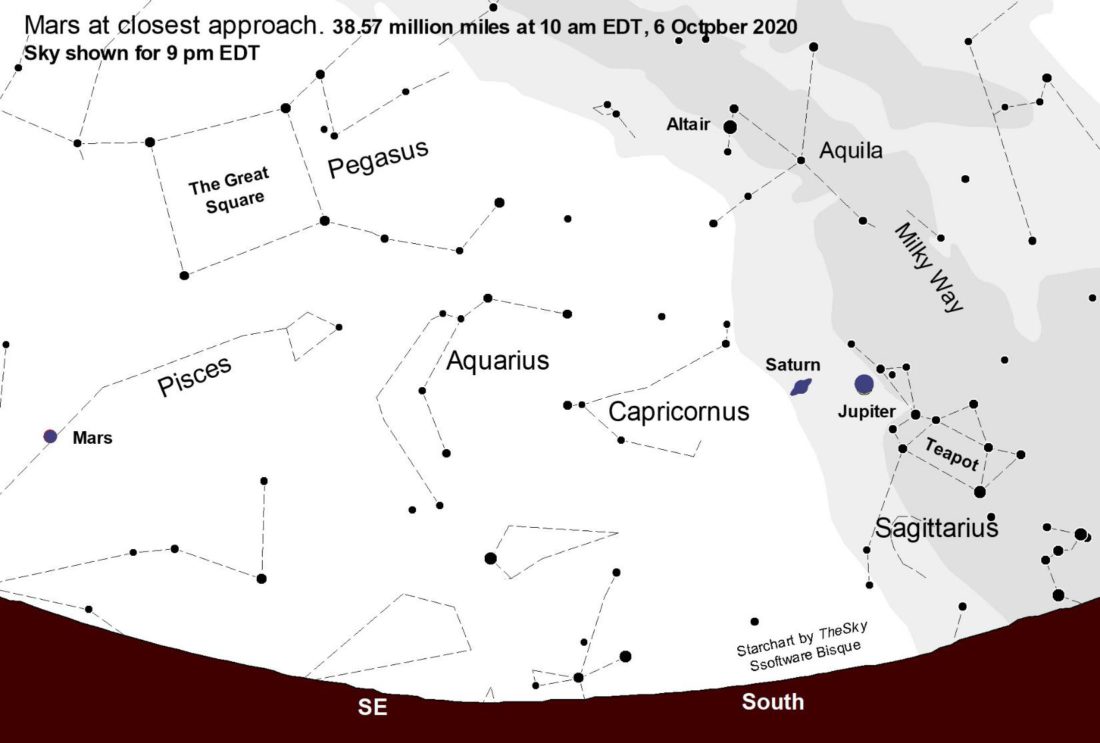Press release from the Pisgah Astronomical Research Institute:
The planets: October this year belongs to MARS! While Jupiter and Saturn have been gracing our evening skies for several months, Mars has taken a back seat, rising hours after sunset. While Mars will not catch up with his two big brothers, he will soon be rising at sunset to shine brightly low in the east as the evening twilight fades to dark. What exactly is happening? Time is moving on in its “petty pace” (Shakespeare) and, as it does so, the earth rotates on its axis daily and orbits the sun annually. As it does so, the other planets creep across the sky. So, let us look at Mars in particular.
Mars circles the sun in 687 earth days. This is called its sidereal period meaning as measured with respect to the fixed stars on the celestial sphere. If we were watching this from a stationary observing point, (of which there is no such thing), we would see Mars come around the sun just short of every 23 months. But, as we observe Mars from the earth, we are moving 67,000 miles per hour, chasing the red planet around the sun. It takes a little over 26 months, Mars’ synodic period, for the earth to “lap” Mars. That will happen about 10 a.m. EDT on Tuesday, Oct. 6, when the two planets are a mere 38.57 million miles apart. This is Mars’ closest approach to us until the year 2035. At this point Mars will appear 22.6” across and will slightly displace Jupiter as the second brightest planet. One week later, at 7 p.m. EDT on Tuesday, Oct. 13, Mars will stand in opposition meaning it is on the opposite side of the earth from the sun. But Mars’ orbit is not a perfect circle; neither is the earth’s. These differences cause Mars to be about 413,000 miles closer tomorrow than at opposition a week from tomorrow.
Over the next several months, Mars will gradually drop farther behind planet Earth and, of course, grow dimmer and appear smaller. But this month amateur and professional astronomers will be training telescopes and cameras on the red planet to study carefully its surface markings.
Three spacecraft are on their ways to Mars to take advantage of this opportunity: NASA’s new rover Perseverance carrying the helicopter Ingenuity, China’s Tianwen-1 (Heavenly Questions) orbiter/lander/rover combo, and United Arab Emirate’s Al Amal (Hope) orbiter.
Mercury is also in the evening sky but very low in the sunset as it approaches inferior conjunction on the 25th. Venus, the brightest planet, is high in the east before sunrise.
The stars: We are now in a transition between the stars of summer and those of the autumn. As we look high in the west after sunset, we can still find the Summer Triangle consisting of the bright stars Deneb in the swan, Vega in the lyre, and Altair in the eagle. But in the east, we have the Great Square of Pegasus, the flying horse, rising higher each evening. Accompanying this magnificent animal are all the players in the great story of Andromeda the chained princess and her hero Perseus. First, there are Andromeda’s parents, King Cepheus and Queen Cassiopeia. Cassiopeia is easy to find as she appears as five bright stars in the form of a letter “W.” Above the queen lies Cepheus. He is not as obvious as his spouse, however; look for the shape of a nearly upside-down house with a tall roof peak. Later in the early evening, a rather shy Perseus is just coming up over the horizon.
In the northwest, the Big Dipper, in the constellation of Ursa Major the great bear, is sinking lower with each passing night. Obviously, autumn is not a good time to observe this asterism and, if we have any sort of obstruction, a tree or a mountain ridge, in that direction, we will not see it at all. Various Native American nations had differing traditions regarding the great bear. One common story is that in the autumn, as the bear gets lower in the northwest each night, it is hunted and has been wounded. As the blood falls from the wound, it stains the trees on the earth below producing the fall colors. Finally, as winter approaches, the great bear disappears below the horizon. The Native Americans associated this disappearance of the great bear in the sky with that time of year when bears were no longer active in the forests below.
Celestial Calendar:
Tuesday, Oct. 6, 10 a.m. EDT – Mars at closest approach to Earth, 38,570,000 miles
Tuesday, Oct. 13, 1 p.m. EDT – Mars at opposition
Tuesday, Oct. 13, 3:31 p.m. EDT – New Moon




Before you comment
The comments section is here to provide a platform for civil dialogue on the issues we face together as a local community. Xpress is committed to offering this platform for all voices, but when the tone of the discussion gets nasty or strays off topic, we believe many people choose not to participate. Xpress editors are determined to moderate comments to ensure a constructive interchange is maintained. All comments judged not to be in keeping with the spirit of civil discourse will be removed and repeat violators will be banned. See here for our terms of service. Thank you for being part of this effort to promote respectful discussion.